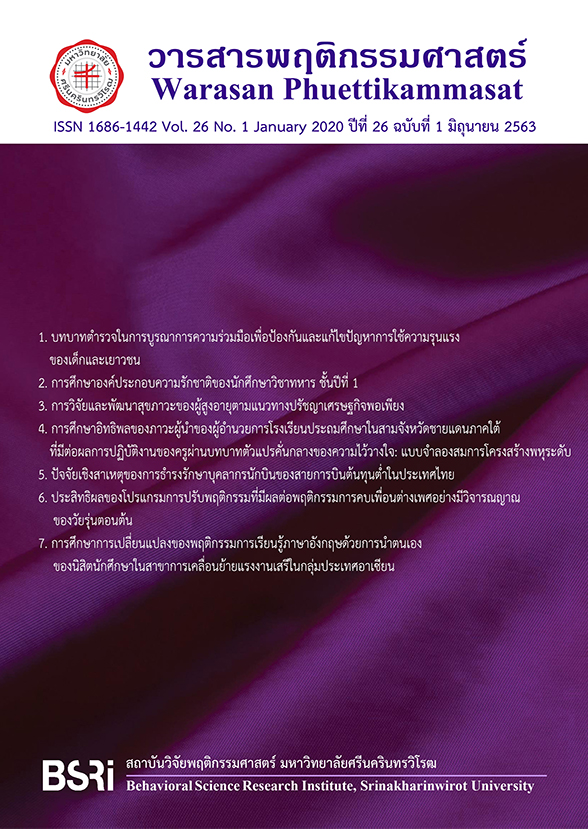การวิจัยและพัฒนาสุขภาวะของผู้สูงอายุตามแนวทางปรัชญาเศรษฐกิจพอเพียง
Keywords:
Sufficiency economy philosophy, development, intervention, well-being, elderlyAbstract
การวิจัยนี้มีจุดมุ่งหมาย เพื่อศึกษาประสิทธิผลของรูปแบบการพัฒนาสุขภาวะของผู้สูงอายุตามแนวทางปรัชญาเศรษฐกิจพอเพียง รูปแบบการพัฒนาสุขภาวะตามแนวทางปรัชญาเศรษฐกิจพอเพียงเป็นการบูรณาการคุณลักษณะทางจิตตามแนวทางปรัชญาเศรษฐกิจพอเพียง 3 คุณลักษณะไว้ ได้แก่ความมีเหตุมีผล ความพอประมาณ และ ภูมิคุ้มกันทางจิต แบบแผนการวิจัยเป็นการวิจัยแบบกึ่งทดลองที่มีการทดสอบก่อนและหลัง พร้อมมีกลุ่มควบคุม กลุ่มตัวอย่างที่เข้าร่วมในการวิจัยครั้งนี้ เป็น ผู้สูงอายุจากชมรมผู้สูงอายุ ในเขตกรุงเทพมหานคร แบ่งออกเป็น 2 กลุ่ม กลุ่มทดลอง ได้รับรูปแบบการพัฒนาสุขภาวะ (20 คน) และกลุ่มควบคุมไม่ได้รับรูปแบบการพัฒนาสุขภาวะ (20 คน) การทดลองรูปแบบการพัฒนาสุขภาวะตามแนวทางปรัชญาเศรษฐกิจพอเพียง ประกอบด้วยกิจกรรม 11 ครั้งๆ ละ 60-120 นาทีใช้เวลา 3 วัน ผู้สูงอายุทั้ง 2 กลุ่มได้ตอบแบบวัดสุขภาวะทางจิต และแบบวัดการดำรงชีวิตตามแนวทางปรัชญาเศรษฐกิจพอเพียง ก่อนการทดลอง หลังการทดลอง และติตตามผลการทดลอง (หลังการทดลอง 4 สัปดาห์) ผลการวิจัยพบว่าผู้สูงอายุที่ได้รับรูปแบบการพัฒนาสุขภาวะ หลังการทดลองมีสุขภาวะทางจิตสูงกว่า (F(1, 37) = 12.01, p < .01, partial eta-squared = .25) และมีการดำรงชีวิตตามแนวทางปรัชญาเศรษฐกิจพอเพียงมากกว่า (F(1, 37) = 8.51, p < .01, partial eta-squared = .19) ผู้สูงอายุที่ไม่ได้รับรูปแบบการพัฒนาสุขภาวะ อย่างมีนัยสำคัญที่สถิติที่ระดับ .05 และในระยะติดตามผลพบว่าผู้สูงอายุในกลุ่มทดลอง ยังคงมีการดำรงชีวิตตามแนวทางปรัชญาเศรษฐกิจพอเพียง มากกว่ากลุ่มควบคุม ผลการวิจัยนี้ยืนยันความมีประสิทธิผลของรูปแบบการพัฒนาสุขภาวะตามแนวทางปรัชญาเศรษฐกิจพอเพียงของผู้สูงอายุ รูปแบบการพัฒนาสุขภาวะเป็นประโยชน์ต่อผู้สูงอายุในการพัฒนาสุขภาวะและมีการดำรงชีวิตตามแนวทางปรัชญาเศรษฐกิจ
Downloads
References
Englewood Cliffs, NJ: Prentice-Hall.
Bandura, A. (1997). Self-efficacy: The exercise of control. NY: W.H. Freeman
Barua, P & TejativaddhanaI, P. (2019). Impact of application of sufficiency economy philosophy
on the well‐being of Thai population: A systematic review and meta‐analysis of relevant
studies. Journal of Population & Social Studies. 27(3), 195-219.
Bhanthumnavin, D. (2017). Sī thotsawat khō̜ng kān khapkhlư̄an lak pratyā khō̜ng sētthakit
phō̜phīang nai sākhā čhit phrưttikam {Four decades of mobilizing the philosophy of
sufficiency economy in psycho-behavioral science}. Journal of Social Development, 19(2),
1-21.
Choochom, O., Sucaromana, A., Intasuwan, P., & Jinnge, P. (2010). Research and development of
intellectual consciousness for Thai youths’ quality of life. Procedia Social and
Behavioral Sciences, 5, 211-215.
Choochom, O. (2014). Antecedents and consequences of psychological immunity. Humanities
and Social Sciences Review, 3(3), 191-197.
Choochom, O. (2015). A causal relationship model of living behavior based on sufficiency
economy philosophy for university students. Procedia Social and Behavioral Sciences,
177, 260- 264.
Choochom, O., Sucaromana, U., Chavanovanich, J., & Tellegen, P. (2019). A model of self-
development for enhancing psychologicalimmunity of the elderly. The Journal of Behavioral Science, 14(1). 84-96.
Collins, J. (2004). Education techniques for lifelong learning: principles of adult learning.
Radiographics, 24(5), 1483-9.
Fitzgeral, S., & Schutte, N. S. (2010). Increasing transformational leadership through enhancing
self-efficacy. Journal of Management Development, 29(5), 495-505.
Foundation of Thai Gerontology Research and Development Institute. (2016). Sathānakān phū s ūngʻāyu Thai Phō̜.Sō̜. sō̜ngphanhārō̜ihāsipkāo [Situation of the Thai elderly 2016].
Bangkok: Foundation of Thai Gerontology Research and Development Institute.
Goleman, D. (1998). Working with emotional intelligence. New York: Bantam Books.
Intasuwan, P. et al. (2005). Kānwičhai læ phatthanā phrưttikam kān bō̜riphōk dūai panyā khō̜ng
yaowachon [Research and development of youth appropriate consumption behavior].
Bangkok: Behavioral Science Research Institute, Srinakharinwirot University.
National Elderly Committee. (2009). The 2nd National Elderly Plan (2002-2021). Bangkok: Ministry
of Social Development and Human Security.
National Statistical Office (2016). Sukkhaphāp čhit ( khwām suk ) Khon Thai Phō̜.Sō̜. ō̜ngphanhārō̜ihāsippǣt
[Mental Health Survey 2015]. Bangkok: National Statistical Office, Ministry of Information
and Communication Technology,
Nuchniyom, C. (2018). Kānphatthanā khunnaphāp chīwit khō̜ng phū sūngʻāyu dūai withī
phutthabūranākān [The development of life for the elderly by Buddhist integration].
Journal of MCU Peace Studies, 6(2), 624.
Office of National Economic and Social Development Board. (2017). The twelfth economic and
social development plan (2017-2021). Bangkok: Office of National Economic and Social
Development Board.
Olson, E. A., & McAuley, E. (2015). Impact of a brief intervention on self-regulation, self-efficacy
and physical activity in older adults with type 2 diabetes. Journal of Behavioral Medicine, 38(6), 886-898.
Phra Brahmagunabhorn (P. A. Payutto). (2017). Withī khit tām lak phut tham [Buddhist thinking
method]. Bangkok: Siam Printing..
Seligman, M.E.P. (1998). Learned optimism. New York: Silmon & Schusier.
Sufficiency Economy Movement Sub-Committee (2007). Sufficiency economy and implications.
Bangkok: Office of National Economic and Social Development Board.
Yaemyuen, A. (2017 Patčhai chœ̄ng hēt bǣp būranākān thāng čhit phō̜phīang čhit laksana læ
sathānakān thī kīeokhō̜ng kap phrưttikam kāndamnœ̄n chīwit tām lak pratyā sētthakit
phō̜phīang khō̜ng yaowachon nai chumchon : wikhro̜ mōdēn samakān khrōngsāng
{Sufficient mind, psychological characteristics, and situations predicting sufficiency
economy behavior of youths: An analysis of structural equation modeling]. Journal of
Social Development, 19(1), 23-37.
Downloads
Published
How to Cite
Issue
Section
License
Behavioral Science Research Institute, SWU
114 Sukhumvit 23, Bangkok 10110, Thailand.
Tel.02-649-5000 # 17600



